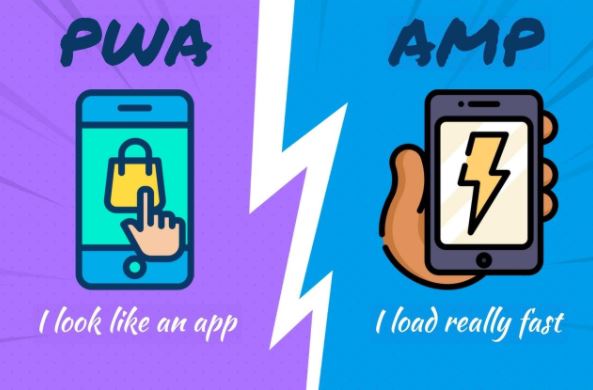Mobile phones have become an essential need of every person in this digital era. People surf and explore the web to retrieve some useful information. Today, many organizations are working to offer better and advanced services to mobile users. There are two terms, PWA and AMP, which are related to the website designing. PWA and AMP are used to provide the best web experience on mobile to users.
PWA and AMP, both these technologies have the same objective – displaying web pages on mobile phones or smartphones and improving the user experience. In this article, we shall see AMP vs PWA.
What Are PWA And AMP?
PWA
PWA implies Progressive Web Application. As its name suggests, it is the web page or web app which looks the same as that of the mobile app. PWA combines features supported by the latest browsers, web APIs, design ideas, and technologies. Thus, its UX is great on both desktop and mobile apps.
AMP
AMP implies Accelerated Mobile Page. People find any web page interesting if it loads faster. AMP is specially meant for enhancing the page-loading performance and offering the best web page experience to users on their mobile devices. It loads any web page faster than HTML.
In website designing, the ‘https’ website owners use AMP and PWA together to make the website more exciting and offer the best user experience. You have understood what AMP and PWA are. We shall now discuss some pros and cons of AMP vs PWA.
Pros and Cons of PWA and AMP
PWA pros
- PWA is responsive, as it is compatible with desktops, mobiles phones, tablets, and other future devices.
- It is progressive because it is suitable for all users, even if the browser choices vary from person to person.
- One of the design concepts used by the PWA is App Shell, which has a faster load time.
- Another best feature of PWA is it is secured and spy-free, as users can access it through HTTPS.
- It enables users to bookmark or save their favourite web app on the home screen.
- PWA is inexpensive than native apps. You can use PWA to build the native app if you do not possess sufficient resources.
PWA cons
- PWA functionalities are not entirely supported by all devices. For example, iOS devices do not support the PWA features, like notifications and shortcut prompting on the home screen.
- It also does not involve native app features, like calling, sending SMS, reading voicemail, sending MMS, accessing calendars, browser, contacts, camera, etc.
AMP pros
- With AMP, web pages or websites get loaded within no time.
- All advertising formats are supported by AMP.
- If you are creating content-based websites, AMP is the best option.
- It reduces the page load time to less than a second.
AMP cons
- Except for an off-the-shelf AMP library, AMP does not allow JavaScript functionality.
- It cannot track user activities and is not suitable for e-commerce websites.
- The greatest drawback of AMP is it cannot increase the search engine ranking.
AMP vs PWA
- AMP is used for reducing the page load time and PWA loads the web page faster as much as possible.
- PWA is specially used for designing E-commerce websites, whereas AMP is used for designing content-based websites.
- AMP involves JavaScript and CSS, while PWA includes App Shell, Service Worker, etc.
- PWA enables users to take advantage of modern browser’s latest features and get the best experience. And AMP makes the AMP versioned content visible on the front page.
Conclusion
When you have an e-commerce website, you must adopt PWA web technology, where users feel the website as the mobile app. Use the AMP technology for content-based websites. You can work with both these technologies together.
